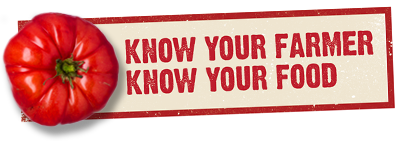Michelle Knapik, Environment Program Director

I’m not sure I’d pose this question quite this way in too many settings, but I’m at a gathering of funders who are working at the intersections of sustainable agriculture, food systems, smart growth and sustainable communities, so throwing around the KYF acronym is acceptable, but my hope is that the issue of whether you Know Your Farmer and Know Your Food (USDA’s outreach campaign ) is one that more and more foundations will help communities address. Currently, we are a nation comprised of predominantly KYF challenged people. When introducing the topic of food systems, the moderator of our first panel discussion, Gail Imig, Program Director at the W.K. Kellogg Foundation said “we’ve lost our way.” In fact, based on the cultural currency of industrial agriculture and commodity markets, funders and others have felt compelled to reintroduce the words “food” and “natural resources” because of the tenuous association.
I have to say that exploring the benefits and opportunities of re-regionalizing our food systems, including urban-rural linkages and the frontiers of urban farming, is no straight line assessment. It is about land use and preservation (No Farms, No Food), food production, “control of choice” in disinvested urban neighborhoods, food access, food justice, human health, green jobs, eco system services, climate change, community revitalization, local economies, and, dare I say, the future of our relationship to the land.
Finding our way to KYF-KYF seems to hinge on “the local integration of food systems” (a slight, but important distinction from pure local food production, which was highlighted by Dr. Mike Hamm, C.S. Mott Professor of Sustainable Agriculture at Michigan State University). Here’s a quick rundown on what local integration entails: farm to fork concepts (I learned that the “direct to consumer” food pathway has grown 100% in the last decade and is projected to be a $7 billion enterprise by 2012); farm to institution initiatives, including farm to school efforts (Dodge supports Fair Food Philly’s farm to institute program in the Greater Philadelphia region); fresh food financing initiatives (the Obama Administration is interested in seeing The Reinvestment Fund’s FFFI go national in scale); healthy corner store efforts; Community Supported Agriculture (CSA), or, for the urban at heart, City Supported Agriculture; Buy Fresh, Buy Local campaigns; and the expansion of SNAP (Supplemental Nutrition Assistance Program) outreach efforts. Carol Kramer LeBlanc, the US Department of Agriculture (USDA) Director of Sustainable Development, framed many of these strategies as “key ingredients to creating regional food systems and urban farms” (for policy geeks, just knowing that this position exists at USDA is the equivalent of comfort food).
The group of funders ended up talking about public policy strategies that touch on both supply and demand for regional foods. We heard about creative solutions and systems thinking in urban centers across the country (Detroit, Cleveland, San Francisco, Seattle, Atlanta, Newark, etc.), including the regional food system study from the Delaware Valley Regional Planning Commission (that Dodge supports) and the rise of Food Policy Councils that help communities distill various food interests and perspectives. What we face now, however, are the challenges of accelerating and scaling-up projects and programs for small and medium farms and food enterprises.
Kathryn Colasanti, an Academic Specialist at Michigan State University, helped us think about scale at several levels: 1) the household level (people building skills and saving on food costs); 2) the neighborhood/community level (skill building/entrepreneurial opportunities, plus opportunities to serve youth, formerly incarcerated, and/or other underserved or marginalized groups); and 3) the city level (reduction of blight and the cost of vacant lot maintenance, increased property values, and opportunities for downstream enterprises).
There are still a number of gaps to be filled in on this “going to scale” conversation, as well as a need for “improved economic research on the impact of regional food production,” but I was encouraged to hear about program innovations that point in this direction. Here are some highlights and links: the Detroit Black Community Food Security Network’s D-Town Farm (a 2 acre model urban farm with organic vegetable plots, two bee hives, a hoop house for year round food production, a composting operation, and market arrangements with urban growers in Detroit); the Detroit Garden Resource Program Collaborative (an aggregator of services such as seedling and transplant support, soil testing, tilling services, tool sharing, niche urban ag workshops, etc.); urban farmer collectives; growing season extension technologies; value-added enterprises; food distribution and storage solutions; and local policy initiatives like Cleveland’s “garden zoning” and ordinances that address livestock in the urban core.
As these food system pieces come together, regions will increase their “food production potential,” and we might even see the rise of “Agri Food Districts” in some older industrial cities (depending upon the assemblage of large numbers of vacant lots). But before we once again “lose our way” in the seduction of yield per urban acre or food bucks per urban acre, let’s remember that this exploration started with the notion of reconnecting people with farmers and food. To that end, I point you to the work of the Community Food Security Coalition and their recently published Whole Measures for Community Food Systems. I think this work will help many of us “find our way” to important people, land and food connections. Hey, if the DIY (do it yourself) minded folks spurred a home renovation revolution and market, I bet a KYF generation can spur a regional foods revolution and help build strong local economies. Are you a KYFer?
